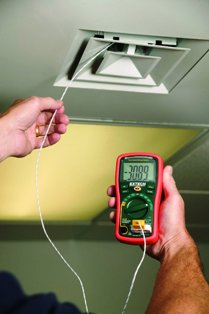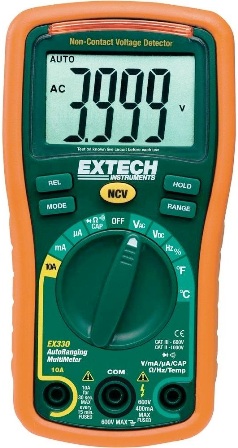Every now and again a great little multimeter comes along and steals the show. The Extech EX330 is a quality brand name meter erring towards the budget end of the spectrum, yet it comes with some excellent features, such as non-contact voltage detection, temperature measurements and capacitance.
It has all standard features, such as voltage / current, resistance and continuity checks, along with capacitance and frequency. The EX330 boasts a pretty impressive 4000-count display and is more compact and tougher than many others in its class. It is also quite accurate; down to 0.5% on DC volts. The Extech EX330 review sees it adept at diagnosing faults in car wiring, household electrics, computers and basic electronics.
>>>See Here For Current Pricing
Key Features
- Compact and rugged
- Auto / manual ranging
- Non-contact AC voltage detector
- Measures temperature
- Frequency
- Capacitance
- Large display, 4000 count
- Data hold function
- Relative mode
- Automatic power off
- Rated CATIII to 600V, CATII to 1000V
Included
- Multimeter
- Two AAA batteries
- Probe leads
- Temperature probe (thermocouple Type K)
- Rubber holster
- Extech EX330 manual (pdf)
In-depth Review of the Extech EX330
Along with measuring the standard things, this meter has several other useful ranges, such as capacitance and frequency. These features are not always included on multimeters in this price bracket today. You can also measure temperature to over 1,000 degrees, and detect cable runs behind a wall with its non-contact voltage detector.
It is an auto-ranging tester, meaning you don’t need to set an individual range when measuring a socket outlet, for example. The auto-ranging is not the fastest, but will work for electronic circuitry up to the meter’s maximum rated voltage of 600V. You can also set it to manual ranging mode, which can be faster.
The screen is nice and large for the meter size, with clear, one-inch high digits. This is easy to see from a distance, although unfortunately there is no backlight.
ACCURACY
| RANGE | ACCURACY | BEST RESOLUTION | |
|---|---|---|---|
| DC voltage | 5 ranges (400mV / 600V) | ±(1.0%+2) @400V | 0.1mV @ 400mV |
| AC voltage | 5 ranges (400mV / 600V) | ±(1.5%+3) @400V | 0.1mV @ 400mV |
| DC current | 5 ranges (400µA / 10A) | ±(1.5%+3) @400mA | 0.1µA @ 400µA |
| AC current | 5 ranges (400µA / 10A) | ±(1.8%+3) @400mA | 0.1µA @ 400µA |
| Resistance | 6 ranges (400Ω / 40MΩ) | ±(1.2%+2) @4MΩ | 0.1Ω @ 400Ω |
| Capacitance | 6 ranges (4nF / 200µF) | ±(2.5%+4) @400nF | 0.001nF @ 4nF |
| Frequency | 8 ranges (5Hz / 10MHz) | ±(0.1%+1) | 0.001Hz @ 5Hz |
| Duty cycle | 0.1 to 99.9% | ±(1.2%+2) | 0.01% |
| Temperature | -4°F to 1382°F | ±(3.0%+8) | 1°F |
* NOTE: Current can only be measured to 10A in bursts of 30 seconds. It will then need to rest for at least 15 minutes before resuming another current test. If you require more substantial continuous current measurements, look to a meatier device like the industrially-rated EX520 or an amp clamp meter.
Extra Features
VOLTAGE DETECTOR
A standout feature of the Extech EX330 is its AC voltage detector; a non-contact sensor good for detecting mains voltage in a wire, at a socket outlet or behind a wall, for example. LED lights light up and a buzzer sounds when it ‘sees’ voltage. Test range is from 100V to 600V AC. Although a great feature, bear in mind it does not display values on screen. More, it ‘detects’ and is not as accurate as pinpointing cable runs in a wall as a voltage stick might be.

THERMOMETER
Also impressive for this price is its temperature measurement capability. A Type K thermocouple wire probe comes included, which plugs into the jack sockets. Temperature is displayed in Fahrenheit or Celsius. You can also get temperature inputs on other multimeters at a similar price point, but it is nevertheless a good deal combined with all the other extras.
RELATIVE (REL)
Good for zeroing out the meter before testing low value resistors or capacitors, relative mode is also used to compare readings with a stored value. You then zero out the meter and the difference will be displayed as a + or – value.
MAX HOLD
With a changing value, this Extech allows you to freeze the reading via the Hold button.
Design/Build Quality
The Extech EX330 Mini Multimeter is very well built. Along with extended features, its build quality is one of its main selling points. It is quite small and solid and features a curved design that is easy to grip with the rubber holster. Also of note is its battery / fuse compartment, which is separately accessed from the rest of the meter via a machined screw. This type of thoughtful engineering is typically only seen on more expensive multimeters.
In addition, the circuit board is quite nicely designed, with decent components arranged neatly amid logical tracks. More importantly, the jack sockets feature solid mounts, with little chance of them bending back and wearing like the cheapos can do. The EX330 also ships with long leads that have handy shrouds for increased safety. The only tangible letdowns are the round bottom and rear of the meter – which don’t sit tight when the dial selector is operated with one hand.
Display and Layout
The big display is intuitive on the EX330. Screen resolution is okay at 4000-count (3 3/4 digits) – the maximum resolution being 39.99. Although there is no backlight, digits are clearly displayed.
The large input dial is centrally-mounted and has nicely defined input ranges – left to right: 10A / mA / μA / res, cont, cap, diode / OFF / Vac / Vdc / Hz,% / °F / °C.
The arrangement is nicely laid out and the interface is easy to decipher – straightforward enough for beginners and easy on the eye for professionals. The jack sockets are standard mount, with Main Terminal / COM (common) / 10A – note the main current (10A) jack, which is on a separate circuit and is separately fused.
Function and Performance
The Extech EX330 performs quite well in most input ranges, although can be a bit slow when in auto range mode. Resistance, capacitance, continuity and the diode checker/beeper are all on the same input position, changeable via the Mode button. Temperature ranges have their own input positions.
There’s a tilting bail on the back for working on the bench, although it doesn’t ground the meter very well and is not much use for clipping over a hanging point. The Auto Power Off function preserves the battery by shutting the meter down when not used for 15 minutes.
BUTTONS
REL – compare two readings
HOLD (MAX) – lock a reading
RANGE – switches between auto and manual ranging
MODE – switches between the various ranges when sharing a given input position
NCV – non-contact voltage detection
Protection
This little multimeter is quite strong, with tough plastics used in its construction and good impact resistance if dropped. The addition of deep grooving around the inside of the case provides blast protection and prevents the ingress of moisture to a degree. Both circuits (main terminal (mA) and 10A) are fused, although fuses are not of the ceramic HRC type. Fuse rating is 10A and 400mA.
AUTO ENGINEERS: While this multimeter is a good addition to an auto engineers’ toolbox, even though the EX330 can measure 10A of current (temporarily), the main fuse can easily be blown when diagnosing battery current draw. Car batteries put out low voltage so amperage is a lot higher than a comparable mains circuit. It might, therefore, be worth investing in a more substantial 10A/20A meter if you’re mostly working auto.
Extech EX330 Pros and Cons
PROS
- Nice size
- Solid construction
- Auto and manual ranging
- Voltage detection
- Many useful features
- Low battery indicator
- Well rated probes and cables
- Good manual – full specs and operational images
- Attractive price
CONS
- No backlight
- Accuracy a bit out
- Sluggish auto range (on resistance especially)
Roundup
Best suited to: Anyone could benefit from having this multimeter. It is good for beginners, home DIY enthusiasts, auto engineers, and electricians. Although the accuracy tolerances may be a bit low for electronics technicians, it performs well enough for its price range and would make a good backup or main meter.
Electricians may find it a bit slow and it is not highly accurate when measuring capacitance, but the review of the Extech EX330 had it contend most input ranges. It can measure mains current (briefly), detect voltage, and also has a temperature input. It competes with much more expensive multimeters and is solidly built, yet has a respectable price.
Alternatives: The EX320 is a bit cheaper, but is without capacitance and REL mode. The Fluke 101 is also a compact alternative.
